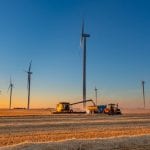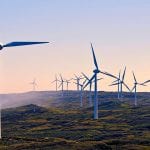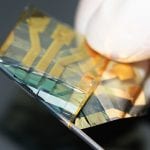Around The Web
Adding cement, power imports to EU ETS most likely start to border CO2 measures -think-tank
US power companies, associations request carbon pricing conference from FERC
Falling electricity prices could favour shift to “mega” wind and solar projects
 Fall in wholesale prices - driven by lower demand caused by pandemic and influx of wind and solar - likely to favour "mega" projects over smaller ones.
Fall in wholesale prices - driven by lower demand caused by pandemic and influx of wind and solar - likely to favour "mega" projects over smaller ones.
The post Falling electricity prices could favour shift to “mega” wind and solar projects appeared first on RenewEconomy.
Coronavirus: live animals are stressed in wet markets, and stressed animals are more likely to carry diseases
Goldman Sachs slashes EU carbon price forecast on mounting bearish factors including COVID-19
Proposed new Irish coalition govt to push ahead with carbon tax increases
The Guardian view on nature’s return: humans making way | Editorial
From coyotes in San Francisco to deer in Romford, animals are taking over streets vacated by people
Few are lucky enough to go wild these days. Under lockdown our horizons have shrunk. Beloved nature reserves and glorious national parks must wait until the quarantine is lifted. Yet the wild is coming to us. In Essex, deer roam a housing estate. In Llandudno, goats charge down the streets. In San Francisco, coyotes prowl the Golden Gate Bridge. Inner-city residents may see a bird of prey overhead for the first time, or notice flashes of colour from butterflies which usually shun their gardens.
Animals are moving into the spaces that humans have vacated, and we are unusually receptive to their arrival. When days seem so indistinct, the appearance of a new bird in a backyard suddenly seizes our attention. A morning walk through a quiet park may have replaced a commute on a packed bus. Birdsong is clearer now that the traffic has hushed.
Continue reading...Updated EU data confirms 2019 saw largest drop in ETS emissions in a decade
Brightening clouds and coral larvae: study picks best Great Barrier Reef rescue ideas
Australian government to back 43 concepts in ambitious $150m research and development program
Brightening clouds with salt crystals and deploying slicks of coral larvae to try and limit the impacts of global heating on the Great Barrier Reef are among more than 40 concepts being backed by the Australian government in an ambitious $150m research and development program.
A two-year feasibility study released by the government on Thursday has reduced about 160 potential ideas to a list of 43 that will be funded for further investigation under the Reef Restoration and Adaptation Program (RRAP).
Continue reading...Ontario, oil and gas sector lead Canadian emissions 2% higher in 2018
Climate change: Blue skies pushed Greenland 'into the red'
EU Midday Market Briefing
Refining NZ to join ETS, announces strategic review
‘Mixed with prejudice’: calls for ban on ‘wet’ markets misguided, experts argue
Cultural nuance and wider view of supply chain ignored in debate following Covid-19 outbreak, say those proposing regulation over ban
Attacks and calls to ban “wet markets” because of their potential for spreading diseases such as Covid-19 may be missing the point, say experts.
Earlier this week Sir Paul McCartney, a long-time vegetarian campaigner, called wet markets “medieval” and said that it made sense to ban them. “When you’ve got the obscenity of some of the stuff that’s going on there and what comes out of it, they might as well be letting off atomic bombs. It’s affecting the whole world.”
Continue reading...$150 million to drive innovations to boost Reef resilience
Vegetation projects monopolise credits in Australia’s latest offset issuance
Pandemic shines harsh light on Trump's failure to protect pangolins
Wildlife conservation efforts are essential to preventing outbreaks, scientists and advocates say
For more than five years, wildlife conservationists in the US have been clamoring for the government to provide Endangered Species Act protections to pangolins, a group of imperiled ant-eating mammals that are widely, and often illicitly, trafficked for their scales and meat. The Trump administration, however, has refused to act and that refusal has suddenly taken on grave new implications.
Earlier this year, scientists in China identified pangolins, along with bats, as one of the possible animal hosts involved in the transmission of the deadly coronavirus from wildlife to humans.
Continue reading...Self-isolating animals: eight species that have mastered social distancing
WWF has compiled a list of animal species whose social behaviours make them self-isolation experts. Humans are social beings: we rarely go a day without some form of interaction – either in the workplace, at the shops or at home. The coronavirus crisis is forcing people around the world to spend more time than ever alone, prompting many to rely on digital communication to connect to loved ones.
For many species in the animal kingdom, however, self-isolation is not a new concept. It’s in their instinct. From land mammals to ocean species, many choose to live in solitude outside of essential activity: to eat and to breed
Continue reading...Energy Insiders Podcast: Why WA could take lead in renewable energy transition
 WA energy minister Bill Johnston joins the Energy Insiders podcast to explain his state’s transition plans. “We can make our own rules,” he says.
WA energy minister Bill Johnston joins the Energy Insiders podcast to explain his state’s transition plans. “We can make our own rules,” he says.
The post Energy Insiders Podcast: Why WA could take lead in renewable energy transition appeared first on RenewEconomy.
Australian scientists help unlock potential of flexible and wearable solar
 Australian and Japanese scientists collaborate to design new super flexible, lightweight and efficient solar cells that could be used in wearable fabrics.
Australian and Japanese scientists collaborate to design new super flexible, lightweight and efficient solar cells that could be used in wearable fabrics.
The post Australian scientists help unlock potential of flexible and wearable solar appeared first on RenewEconomy.



